

 HOME |
by Bill Senkus
(The following article is based on one I published
originally in the September-October, 2002 issue of The Dispatcher, the journal of
the Casey Jones Rail Road Unit of the ATA.
I have taken advantage of the greater space
available here to expand on both the text and image content, and plan to add more as time
permits.)
Danish Charity Stamp
(Click on any image to view a larger version)
What is a Cinderella stamp?
According to the web site of The Cinderella Stamp Club of the UK, Cinderellas include
local stamps, telegraph stamps, railway stamps, revenues, fiscals, forgeries, bogus and phantom issues, Christmas, Red Cross, TB and other charity seals, registration labels, advertisement and exhibition labels and many other items
According to Roger and Bonnie Riga of Rigastamps
"Cinderellas" is the nickname given to the stepchildren of stamp collecting, all those
stamps and things that no one can find in Scott's catalog, and that no one knows what to
do with. ... Simply put, if it looks like a stamp, or feels like a stamp and it's not
listed in Scott's catalog then it's probably a Cinderella.
You may have noticed some disagreement between those two definitions of the term. The first includes telegraph stamps and revenues, yet the second implies that anything listed in Scott is NOT a Cinderella, and the Scott US Specialized Catalog includes telegraph stamps and revenues (as well as Christmas seals), so perhaps those are not Cinderellas. My point is that no two collectors seem to agree on a precise definition of the term. One must decide for one's self what it means.
CLICK HERE for more about Cinderellas.
For the purposes of this article, the term "Cinderella" is a catch-all term for anything that looks like a postage stamp, but was either not valid to carry mail, or not issued by an official postal authority.
Note that by my definition, some Scott-listed items such as Revenues, Telegraph Stamps, etc. ARE Cinderellas.
One of the attractions - or turnoffs - of collecting most Cinderellas is that there is no catalog that lists them, hence no way to assemble a "complete" collection, or to know how many were issued, or what they are worth. For some, all of that constitutes a welcome challenge.
About a quarter of CJRRU members say they collect Cinderellas, and I am among them, so I am offering this overview of the area both to help those who already collect it, and perhaps to inspire some non-collectors to join in. Please note that I am not an expert in this area, so my article is far from the final authority on the topic, and I welcome corrections or additions to anything written here. Moreover, there is a lot more one could say about Cinderellas with a rail theme, so if any member wants to take part or all of this and expand on it, I would be pleased to publish the result.
I have made my own categories below, just to help organize this article, but there are certainly other ways to make this chaotic area more manageable. Most of the examples I show below are from the US, the area I collect most actively, but there are many examples from other countries. And keep in mind that this page is about Trains on Cinderellas, so I have confined myself almost exclusively to examples that do show a train or locomotive.
GROUP I - Trains on BOB (Back of the Book)
These are close relatives of postage stamps, i.e., officially issued or somehow directly related to postage stamps. They are items that a hard-core philatelist might allow in his or her album. Many of them are listed in catalogs such as Scott, Gibbons, Michel, and Yvert & Tellier, but in appendices or sections - you guessed it - at the back of the book; therefore, many collectors would say that at least some of these are NOT Cinderellas. I include them here because by my definition they belong - they were not valid as postage.
Trains on Proofs and Essays
- to me these are Cinderellas, since they were neither officially issued, nor intended to carry mail. Yet they are embraced by traditional stamp collectors, and are de rigueur in highest- level philatelic exhibits. Essays are preliminary ideas for a stamp's design, and often show its evolution from initial concept to final product. Proofs are tests of the final design in die form. I like proofs because they usually show a stamp's design in its ideal state, hand printed on high quality paper, and with no plate wear. Below are an essay for Scott US 114, and the stamp as issued. You can see that the designs are slightly different, and the essay is sharper and clearer, with more detail.Below is an image I scanned from an auction catalogue (Alevizos, June 1998), of an essay for a Guatemalan stamp that was never issued. This pushes the envelope a bit further. If it never became a stamp, its only validity is its origin within the postal service. But what a fabulous image!
Auction description: A 1929-32(ca) large (255x355mm) HAND-DRAWN ESSAY for 2 centavos de quetzal stamp (the currency furnishes the approximate date) depicting panoramic scene with central train on elevated railway, also large volcano, plane, trucks, etc. Possibly for Eastern Railway issue.
Trains on Revenues (fiscals)
- these are stamps issued to show the payment of a government tax or fee other than postage, such as the Match & Medicine stamps of the US. Below are Scott US RO86c and RS161d, two of my all-time favorite train stamps, and both magnificent examples of the engraver's craft.
Trains on Telegraph stamps
- In the heyday of the telegraph in the U.S., roughly 1860-1940, these were used to show payment of the fee to send a telegram, and were affixed to the form one filled out. They were produced and sold by the telegraph companies, with no government involvement or regulation. While those in the US (none shows a train) were all printed specifically for the purpose, telegraph stamps in many other countries were overprints of postal or revenue issues, and were issued under government authority or control. The two stamps below are a revenue from Ecuador, and its overprinted telegraph stamp version, YT45.
Trains on Locals and Expresses
- these are stamps or labels issued by private local or express systems. Some reflect the payment of a fee, while others are simply labels for identification purposes. Below are a local stamp (Broadway Post Office, NYC, 1852) and an express company franking (Truman & Co's Express, San Francisco, ca. 1865). Scott lists the former, but not the latter. Both reflect the payment of a fee for transport and delivery of a letter OUTSIDE the U.S. mail system.
These locals and expresses were sometimes used to convey mail to the mail system, and the most prized uses of their stamps are on covers that bear both a non-government carrier stamp AND a U.S. postal system stamp, like the one above.
You can learn a little more about locals and expresses on my page about Trains on US Locals and Expresses, here; and if you would like to see an extensive display of Trains on Express Labels and Stamps, I have created a series of pages here that shows many examples from the US and Canada during the period 1839-1926.
Trains on Railway Parcel and Letter Stamps
- these are stamps issued by a railway to show payment of the fee for transport of parcels and newspapers between railway stations. Material so carried usually had to be delivered to the originating station and collected from the receiving one, though some railway companies offered delivery on the receiving end for an additional fee. This was a popular practice all over the world, but stamps were used in relatively few. The stamps were usually affixed to a waybill, rather than to the item being shipped. (I have created a set of pages showing examples of all the Railway Parcel and Letter stamps that depict trains - Click here.)

Algeria |
Belgium |

France |

New Zealand |
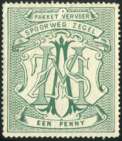
South Africa |
I am including these in the BOB category for two reasons: first, because many of them are listed in catalogues, and second because they were basically Expresses. (Scott lists the Railway Parcel Stamps of Belgium, Yvert & Tellier lists those of France, and I presume Michel lists some, I don't know about Gibbons.) For a lengthy dissertation on why I think these are all Cinderellas (some would disagree with me), click here.
Note that I am NOT talking about the Parcel Post stamps of the United States, which were issued by the post office for transport of parcels that happened to be carried for part of their journey on a train. Those are not Cinderellas. Nor do they have a rail connection, per se. Three of them do, because they show rail vehicles.
I AM talking about stamps issued by a railway, whether with or without official approval, and meant to pay strictly for the rail part of a parcel's journey. Railways of many countries have issued such stamps, but most of them do not depict a train. One device many of them share is the winged wheel, symbol of rail parcel service. The zealots among rail philatelists collect all such issues - having originated with a railroad they are by definition rail-related, whether they depict a train or not. Others, like me, collect only those that depict a rail vehicle of some sort. Countries whose railways have issued such stamps depicting a train include Australia, Belgium, Denmark, Finland, Germany, New Zealand, Norway, Sweden, France, Switzerland, Great Britain, and others. Below are several groups of railway parcel stamps with trains or locomotives on them.
The Railway Parcel Stamps of Great Britain are among the earliest stamp-like adhesives world-wide, and can be divided according to their intended use - ordinary parcels, Newpapers, other items. I have many examples of the first two, but only one of the third. The designs differ significantly from railway to railway, as they were not regulated by the government. Still, few actually show a train. The only ones among those I own that include a train in the design are those of the London and North Western Railway, one of which is shown below, though you may need to click on the image and look at the enlarged version to see it, to the left of the central figure, a tiny steam train on a bridge. Moreover, these were not readily available to the public, except when used, and were discontinued by 1940, so relatively few are available to collectors, and prices for good copies are relatively high. This stamp was in use around 1900 (?) (Click here to see a few more of the GB parcel stamps.)
The railway parcel stamps of Denmark are more appealing to collectors such as me, who prefer items that depict a train or locomotive. They were also more available to the public, so many reached collectors hands, and one can buy them relatively cheaply. Moreover, there are a large number of different designs, plus a comprehensive illustrated catalog (though it's in Danish), so one can have the satisfaction of a moderate challenge, with the realistic hope of a complete collection. Below are a few of my favorites. (Click here to see a few more of the Danish parcel stamps.)
Most of the items above are part of sets, all with the same design, differing in denomination and color. Below are two package labels, showing how the Danish stamps were used. It is my understanding that they are neither issued nor used any more, and while many of the small private railways have died, some do survive. They just use other methods of showing payment for parcels. Here is a link to an excellent website that lists all the railways of Denmark.
Below, sorted by country, are examples of railway parcel stamps from some other countries - most of what I know about these is revealed on my page devoted exclusively to that topic - Click here.

Algeria |

Australia |

Finland |

Germany |

Norway |
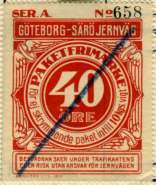
Sweden |

Switzerland |
2/9/14 - NOT A RAILWAY STAMP!
Salo Heimann, webmaster of the Scandinavia Philatelic Society in the UK, wrote to point out that the stamp I had listed directly above as an example of a Swedish Railway stamp, was in fact Danish. I verified that, and asked Google to translate Dampskibsselskabet Skjelsk°r, the text on that stamp. I found it means "Steamship Company Skjelsk°r" in Danish, so apparently it isn't even a railway stamp, but a steamship stamp! I replaced the image above with a true Swedish stamp, and below is the Danish one, properly identified. Thanks, Salo.
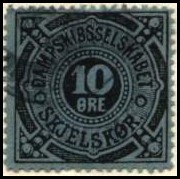
Trains on Railway Letter stamps
- Railroads in several countries issued Railway Letter Stamps, but Great Britain is the only place I know of where these were officially sanctioned, during the period 1891-1941. They were essentially express mail stamps. There were also stamps issued and used in the UK before that period, with sometimes questionable authority, for what amounted to private mail service by railroads. The area is a complex and interesting one, which I will not try to examine here. There are authoritative publications on the topic by the Railway Philatelic Group of the UK, whom I suggest you write if you wish to learn more. (NB - the modern "Railway Letter Stamps" issued by tourist railways and Preservation Societies such as the Tallylyn and Festiniog of Great Britain do not fall into this category - they are souvenir labels.) Below are a few of the real British Railway Letter Stamps. Because these stamps were issued with government approval, and under government supervision, all the designs are essentially the same, differing only in the name of the railway, the denomination, and the color. None shows a train or locomotive, so they tend to appeal only to the serious collector. (Click here to see a few more of the GB Railway Letter stamps.)
The only other countries where Railway Letter Stamps were issued are Netherlands and Iraq. South Africa had a railway letter service but issued no stamps.
I have created a set of pages showing examples of all the Railway Parcel and Letter stamps
that depict trains - Click here.
GROUP II - Trains on Phantoms and fantasies
Many people have created stamp-like labels with imaginary country names and meaningless denominations, often for fun, but also to bilk collectors. Others have created phantoms and fantasies for special purposes.
The train items in this group are mostly a modern phenomenon. The only example I can think of that is more than fifteen years old is this so-called "Movie Stamp" created by a Hollywood film studio in 1945, and subsequently reproduced privately for collectors. The October, 2002 American Philatelist has an article about it, and many others have been written in the 57 years since it was created.
In the early 1990's, as the new countries of the former Soviet Union established their own postal services, many overprints on stamps of the USSR were created with names of non-existent countries such as Gagausian Republic and Ingushia. Many of these showed trains. Here are just two:
In more recent years, more professional-looking phantom issues have been created with country names like Abkhazia and Batum. Most of the entities named on these do exist, but are regions or states within the Russian Republic, somewhat like states of the USA. Some collectors and collector organizations get very upset about these creations, but my philosophy is that if you know them for what they are, and like them, why not collect them? The cover below is a particularly egregious attempt to "authenticate" one of these issues, from Tatarstan, which according to a Washington Post news article of 1997 "has no separate army, currency or postage stamps. These are all Russian." Everything about this 1996 cover is bogus, especially the CCCP "cancel", something no one would dare use officially since the breakup of the Soviet Union. It's pure fantasy.
The Collectors Club of Chicago has issued a report that lists all the known bogus stamp "countries". It is available on the Internet, at http://www.askphil.org/. Click on REPORTS, then select number 4.
GROUP III - Trains on Poster Stamps
As the name implies, these are miniature posters, with designs that were - or could have been - used as actual posters. Many are perforated like postage stamps. They tend to be large and colorful, with striking designs, and text advertising a product or place or event. The US and Germany seem to have produced the majority of the poster stamps. They are the largest sub-category of Cinderellas, and can be further subdivided into many other sub-categories, according to your taste. Here are the ones I favor:
Product advertising - This is probably the largest subdivision of poster stamps. Sometimes it's hard to figure out why the design used a train, though - I've no problem with the first two below, but what did Sanforizing have to do with a steam locomotive?
Philatelic Exhibition Seals
- This is another large subset of poster stamps, for obvious reasons. Trains are a popular subject on them, since they once figured so prominently in moving the mails. The best of these were the early ones, engraved and printed by security printing companies like the American Bank Note Company. I have created a separate page to display all the Philatelic Exhibition Seals with a train theme, HERE. Below are three of my favorites.
1936 1936 1926
Propaganda seals
- these try to sell an idea, not a product.
Safety campaigns -
The introduction of the automobile created a whole new safety risk, as early drivers seemed unable to recognize the dangers. Children and streetcars on city streets were a dangerous combination. Poster stamps were an effective tool for spreading the word.
1924 1910 (?) 1922
Patriotic labels
- patriotism is another popular topic on poster stamps, but few have a rail theme. All the ones I own date from WW II, were issued by railroad companies, and strike me as self-serving, which makes them seem more like advertising than patriotism. The text in the tab of the strip below reads "Use these poster stamps on your business and personal mail, on bills returned to stores when making payment and on similar correspondence."
Places and Scenery
- Many of these have little or no text, other than the name of the place depicted, and hence are difficult to identify, unless you can find them in a complete pane, in which case the selvage often tells who produced them, and why. Railway companies created many such poster stamps depicting the scenery along their routes, though few of those included a train image. Towns, cities, and states also issued poster stamps to promote tourism.
Events (non-philatelic)
- All of the great fairs and exhibitions of the late nineteenth and early twentieth centuries were promoted with poster stamps, some issued before the event, some during. Trains were a popular method of transport to and from such events, as well as a symbol of industry and progress, so are often depicted on such poster stamps. Theme parks seem to have replaced the great fairs and expos these days.
I am especially fond of poster stamps in series issued over consecutive years, and with the same or a similar design. The second and third designs above belong to that category. The train on the third one is hard to see even first-hand - it's the dark area to the right of the figure's left foot.
Railway company labels
- Most rail companies issued poster stamps to promote themselves and their trains. These are a form of product advertising, I suppose, but are a large enough area, and one important enough to CJRRU members to deserve their own category.
Souvenir labels
- I put the modern "Railway Letter Stamps" of the UK in this category, plus anything else created for tourists to carry away as a souvenir of some recreational experience. I know of no US railroad that has tried to exploit this market, but there is at least one in Canada.
There is one book I know of about Trains on Poster Stamps - it is Poster Stamps - Trains - Including Railways and Railway Stations. An Introduction to collecting poster stamps having images of trains, railways and railway stations. Prepared in conjunction with TRAINS 1999, the International Stamp Exhibition at the Wembley Exhibition Centre, London, 15th to 18th April 1999, by Charles Kiddle of the UK, probably the world's greatest authority on poster stamps. He estimates the number of poster stamps with trains to be in excess of 5,000. The book is expensive ($45), and really simply the catalog of an auction at the show named in the title, but it has 24 pages of full-size, full-color high-quality reproductions, and to me it was worth the price. Available in the US from The Printer?s Stone, PO Box 30, Fishkill, NY 12524.
Group IV- Trains on Miscellaneous stamp-like objects
This group includes pretty much anything that does not fit into the previous groups, but looks like stamp.
Trains on Charity Seals - Christmas Seals, Easter Seals, etc. Trains have always been a popular theme on Christmas cards, but not on Christmas seals for some reason. The block below, from 1967, is one of the few I have found. It's a nice design with the train running on ten stamps one direction, then on the ten below in the opposite direction. I show only half.
And here is a similar design from Germany, 1959.
Two more - USA, 1972, and Sweden, 1965.
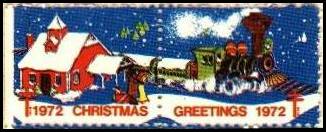

The "Vereniging voor Personeel in Dienst der Nerlandsche Spoorwagen tot Bestrijding der Tubercolose" (Netherlands Association of Railway Workers to Fight Tuberculosis) issued yearly stamps from 1937 to 1971, a total of 30 stamps (missing a few years during WW II), 33 counting variations or perforation differences. Not all show trains. Below are all of those I have with an explicit rail theme.
 1946 |
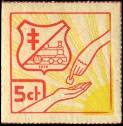 1947 |
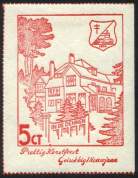 1953 |
 1961 |
 1965 |
 1967 |
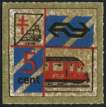 1968 |
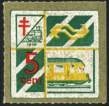 1969-70 |
At the top of this page I show one stamp from a multi-year set issued in Denmark. Below is another of these stamps, and Here is a link to a separate page with all the stamps I own from the set. According to Christoffersen's catalogue of Scandinavian Christmas seals and charity stamps, these stamps were issued every year from 1914 through 1957, each year with the same design, differing in color and of course date. The denomination was 1KR from 1914 through 1947, then 1.5KR from 1948 trhough 1957. They were printed in sheetlets of nine stamps, one stamp wide by nine long(!). They funded medical care for railway personnel and their families.
Trains on Mail Art and Artistamps
- these are a relatively recent phenomenon - the earliest examples I know of date from the mid-1960's, and the concept gained popularity in the 80's. Some modern artists like the challenge of creating works of art as small as a postage stamp, and enjoy carrying the process all the way to printing, perforating, and gumming their work. Some also put their creations on the mail they send, either as decoration or in place of stamps, to see if they can fool the authorities. Some have been severely chastised. The two I know of who have produced items with trains are Steve Smith, whose work is often somewhat risqué, and Dennis P Jordan.
Steve Smith Dennis P Jordan
GROUP V - Trains on non-stamp items
This is the nether reaches of Cinderella collecting, and includes items that are still no bigger - or not much bigger - than a stamp, but do not try to look or act like one. Once one gets hooked on the sort of material shown above, anything goes, so I do collect these in a casual way, especially when they show a train.
The sorts of things that fit into this category include Product Labels, Matchbox labels, Match book covers, Cigarette cards, Trading cards, Return address labels, Baggage labels, Decals, and miscellaneous seals. If it shows a train, I might buy it. Below are some favorite examples.
Prior to 1850 or so, envelopes were seldom used for letters. One folded one's letter and sealed it shut with wax, stamping the warm wax with one's personal seal for security. When envelopes came along, they had no adhesive initially, so the same method was used to seal them - wax dripped onto the back and impressed with a seal.
As envelopes evolved, adhesive was added, and the wax was no longer needed, but people were used to the circular blob on the back of their envelopes, so at first they continued to use the wax, but then they had paper seals like these made, and glued them on. Long after the concept made sense, well into the twentieth century, people continued to use the seals, since they added some additional security, and declared the source of the letter quite impressively.
These seals were especially popular in Germany and Austria-Hungary, which is where all of mine originate. Above are a few. If you want to see more, GO HERE.
Matchbox labels are a popular collecting area that covers many topics. Many series of labels have been issued specifically to attract collectors, with trains and railroads a popular theme. The Russian set above is just one, promoting safety around trains. Unfortunately, I do not read Russian, so I cannot provide a translation of the text, and while some of the images make the meanings pretty clear, others puzzle me.
With the dramatic reduction in smoking world-wide, matchbox labels may soon go the way of the pet rock. I've not seen any recent sets - most are 1970's or earlier.
If you want to know more about this topic, visit the delightful and extensive Virtual Matchbox Labels Museum.
The cards above are my favorite twelve of a set of fifty. I especially like the very scholarly, informative text on the backs of the cards.
Cigarette cards were once immensely popular, and I can think of no modern equivalent. They died long ago, I don't think any were produced later than the 1950's. One got a card in each pack of cigarettes, and most cards were part of sets, so one had to trade with other smokers to get the complete set. Then one could purchase a special album to mount them in.
This is a business card, one of a series created by Michael Bean, plate printer at the Bureau of Engraving and Printing, who travels often to philatelic and numismatic shows to demonstrate traditional printing techniques. It's not much bigger than a stamp, and it's so attractive, why not call it a cinderella?
This is a cigar label, and its shape is rather un-stamplike. Then again, look at that Revenue Stamp, back near the top, RS161d - if that's a cinderella, why not this?
Above are a couple of wine labels a kind friend picked up for me at a wine tasting - he knows my love of trains and cinderellas. The size is becoming a little problematic, these are 3" x 4". But such nice trains, and my name is Bill! I'm not Dutch, though.
Whiskey and brooms? Why not, sounds like a fine combination. Way beyond stamp size, but such nice trains!
Baggage labels from classic era trains are hard to resist. They're paper, they're gummed, they must be stamps!
You get the idea. What to collect is up to you. If you share my passion for train images, don't let terminology prevent you from collecting and enjoying whatever catches your fancy.
PRICES, and WHERE TO BUY THEM
Except for the items in Group I, prices for most of the examples I have shown should be under $10. I assume if you collect this material, you have found good sources, but for the record, here are the ones I have used:
The Rail Philatelist
- Al Peterson is a member of the CJRRU, and probably the US dealer with the largest rail philatelic stock. Visit his web site at http://www.railphilatelist.com/ to see his show schedule, or e-mail him and ask when he will be in your area. He has a good stock of Cinderella material in most of the categories I define above.Bruce L. Hecht - Another CJRRU member-dealer who specializes in train stamps, he works primarily on the East Coast. E-mail him at bhect@optonline.net, or write him at PO Box 474, New Hyde park, NY 11040.
Rigastamps - Roger and Bonnie Riga are my favorite dealers specializing in Cinderellas, partly because they always have something interesting at a reasonable price, but also because they do a lot to educate collectors about the area, with regular articles in major philatelic publications and a constant willingness to share their encyclopedic knowledge of the area. Web site at http://www.rigastamps.com/. You can write them at Rigastamps, P.O. Box 326, Eaton, OH 45320-0326 USA
eBay - I could fill an entire issue with advice on how to use the Internet to add to your collection, but the best way to learn is to do it. The best tip I can offer on eBay is Deal only with sellers with plenty of positive feedback.
PSS - The Poster Stamp Society (US) - this is a small group run single-handedly by a great guy named Walter Schmidt. He publishes a monthly newsletter, most issues of which include an auction. Train items show up occasionally. No web site, write him at Walter Schmidt c/o Cinderella Publications, 3654 Applegate Road, Jacksonville, OR 97530 USA
CSC - The Cinderella Stamp Club of the UK - I do not belong, but they have been recommended to me by various people, so I pass that along. Web site at http://www.cinderellastampclub.org.uk/ - or write to Don Millington, 1 Keystone Gardens, Ludlow, Shropshire SY8 1LE, UK
Auctions - Many philatelic auctions include Cinderella material. I have bought several collections through Greg Manning Auctions, which specializes in collections.
Stamp shows and bourses - any large stamp show will have at least one dealer with Cinderellas. Ask around and you may be surprised how many dealers have a box or album they acquired as part of a philatelic collection, and would love to sell as a unit.
Other collectors - some of my best material has been acquired from other collectors. Each CJRRU member gets one free ad per year in The Dispatcher, our newsletter, so why not use it to connect with someone else who collects what you do?
 HOME |
Send feedback to the webmaster: CLICK HERE
Revised -- 02/15/2020